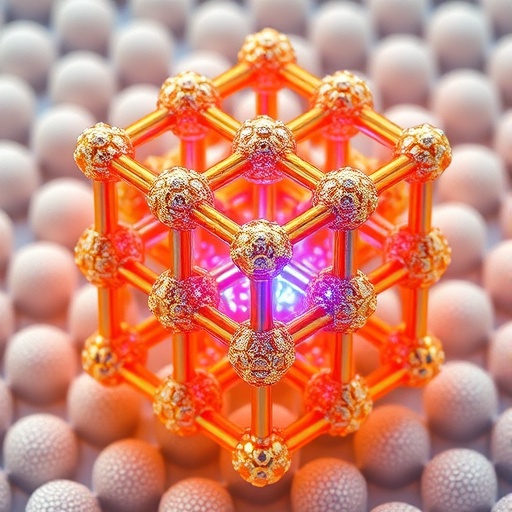In a groundbreaking advancement at the intersection of materials science, bioengineering, and medical diagnostics, researchers have unveiled a novel approach to detecting ammonia (NH₃) levels with unprecedented reliability and sensitivity. This innovation revolves around the strategic stacking growth of ionically conductive metal-organic frameworks (MOFs) on flexible biofabric substrates, culminating in a flexible, wearable sensor capable of monitoring ammonia concentrations relevant to hepatic encephalopathy diagnosis. The research, recently published in npj Flexible Electronics, heralds a new era in non-invasive medical diagnostics leveraging next-generation materials and device architecture.
Hepatic encephalopathy (HE) is a debilitating neuropsychiatric condition arising due to liver dysfunction, where the accumulation of toxic metabolites, especially ammonia, results in cognitive impairment and neurological decline. Accurate and timely detection of elevated ammonia levels in bodily fluids is crucial for early intervention and improved prognosis in HE patients. Traditional ammonia sensing methods frequently suffer from limitations such as invasiveness, poor specificity, and lack of real-time monitoring capability. Thus, a flexible, reliable sensor that can continuously track ammonia levels holds immense clinical significance.
The core innovation centers on integrating MOFs—highly porous, crystalline compounds composed of metal nodes connected by organic linkers—onto biofabric substrates that are both flexible and biocompatible. The research team engineered a stacking growth technique, layering ionically conductive MOFs precisely onto natural fabric matrices. This construction not only maximizes the contact surface area for effective ammonia capture but also forms a stable ionic conduction pathway critical for reliable signal transduction.
Metal-organic frameworks, with their tunable pore sizes, chemical versatility, and substantial surface area, have been extensively explored for gas sensing applications. However, incorporating them into wearable electronics has posed significant challenges due to mechanical fragility and integration difficulties. The unique approach of “stacking growth” over biofabric substrates circumvents these issues by exploiting the inherent flexibility, breathability, and skin compatibility of fabrics, thereby enabling seamless human-machine interfacing.
This sensor design operates on the principle of ionic conduction modulation within the MOF layers upon exposure to ammonia gas. When NH₃ molecules infiltrate the porous MOF network, they interact with the ionic carriers, altering the overall conductivity. Such a measurable change can be captured as an electrical signal corresponding directly to ammonia concentration. The rich porosity and selective adsorption characteristics of the MOF layers ensure high sensitivity and selectivity, even amid confounding gaseous environments.
Fabrication protocols employed in this study demonstrate precise control over the thickness and uniformity of the MOF coatings by iteratively stacking multiple layers, enhancing the sensor’s performance metrics dramatically. The stacked configuration effectively prevents delamination issues commonly associated with thin-film coatings on textiles, ensuring device durability under repeated mechanical deformation, such as bending, twisting, or stretching.
To validate their sensor’s efficacy, the researchers conducted extensive analytical characterization and real-world testing involving simulated physiological conditions replicating human sweat and breath. The results confirmed the sensor’s ability to detect ammonia concentrations spanning from sub-ppm (parts per million) to clinically relevant levels associated with hepatic encephalopathy. The dynamic response featured low hysteresis and rapid recovery times, essential for continuous patient monitoring.
Moreover, the sensor exhibited excellent mechanical robustness, maintaining consistent performance even after multiple washing cycles and prolonged wear, a testament to the durability of MOF-biofabric integration. This characteristic is critical for practical wearable devices intended for daily use and long-term health monitoring, where reliability and user comfort are paramount.
Another remarkable aspect of this technology is its compatibility with low-power electronics, including flexible substrates for data acquisition, signal processing, and wireless transmission modules. The integration potential paves the way for a fully flexible and wearable platform capable of non-invasive, real-time biochemical sensing, which could revolutionize not only hepatic encephalopathy management but a broad spectrum of metabolic and environmental monitoring applications.
The researchers also highlight the scalability and cost-effectiveness of their stacking growth method, suggesting promising pathways toward mass production. By leveraging common textile materials and solution-based growth processes, this technique aligns well with industrial manufacturing paradigms, increasing the likelihood of rapid commercialization and widespread adoption in clinical and consumer healthcare markets.
Beyond medical diagnostics, the implications of such ionically conductive MOF coatings on biofabric extend into flexible electronics, smart textiles, and environmental sensing domains. The synergy of selective molecular recognition combined with wearable form factors opens up novel avenues in personalized healthcare, occupational safety, and air quality monitoring.
Fundamentally, this work represents a pioneering fusion of chemistry, materials engineering, and biomedical application, demonstrating how nanoscale phenomena in MOFs can be harnessed for macroscale impacts in human health. The study’s comprehensive approach—from molecular design, device fabrication, to practical validation—sets a new standard for crafting multifunctional wearable biosensors.
Looking forward, future research trajectories may focus on expanding the range of detectable biomarkers using bespoke MOF compositions and further miniaturizing the integrated circuitry to realize fully autonomous sensing platforms. Additionally, integrating machine learning algorithms could enhance data interpretation and predictive capabilities for proactive disease management.
In essence, the stacking growth of ionically conductive MOFs on biofabric substrates marks a transformative leap in the development of wearable chemical sensors. By delivering reliable, real-time ammonia monitoring tailored for hepatic encephalopathy diagnosis, this technology stands to significantly improve patient outcomes while offering a versatile platform adaptable across diverse sensing challenges in modern healthcare.
Subject of Research: Development of flexible, ionically conductive metal-organic framework biosensors on biofabric for ammonia detection relevant to hepatic encephalopathy diagnosis.
Article Title: Stacking growth of ionically conductive MOF on biofabrics enables reliable NH₃ sensor for hepatic encephalopathy diagnosis.
Article References:
Liu, K., Xu, Y., Tian, X. et al. Stacking growth of ionically conductive MOF on biofabrics enables reliable NH₃ sensor for hepatic encephalopathy diagnosis. npj Flex Electron 9, 67 (2025). https://doi.org/10.1038/s41528-025-00445-0
Image Credits: AI Generated




